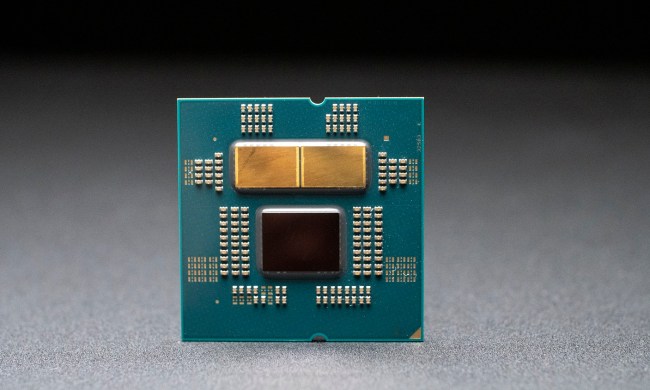Pairing Ryzen CPUs with Radeon Vega graphics is a great idea. It goes far beyond what’s possible with Intel’s onboard graphics options, and distinguishes AMD a bit from its competition. However, not many manufacturers have included these APUs in laptops or desktops so far.
That’s beginning to change, though. At a press event last Friday, AMD announced a series of new APUs made for enterprise laptops, but more importantly, some significant support from the biggest PC manufacturers. AMD says that with the inclusion of these new APUs, this is the broadest portfolio it’s ever had.
Ryzen Pro Mobile APUs

AMD announced three new mobile APUs, which have been picked up in a variety of new systems from different OEMs. They’re all quad-core CPUs using the Zen architecture and include Radeon Vega graphics onboard.
Here’s the specs you can expect from the three levels of Ryzen Pro APUs:
| APU | Pro 2300U | Pro 2500U | Pro 2700U |
| Processor | Ryzen 3 | Ryzen 5 | Ryzen 7 |
| Graphics Version | Radeon RX Vega | Radeon RX Vega | Radeon RX Vega |
| Compute Units | 6 | 8 | 10 |
| Cores | 4 | 4 | 4 |
| Threads | 4 | 8 | 8 |
| Base Clock Speed | 2.5GHz | 2.0GHz | 2.2GHz |
| Boost Clock Speed | 3.4GHz | 3.6GHz | 3.8GHz |
| Wattage | 12-25W | 12-25W | 12-25W |
If you’re familiar with the matter, you might notice these Ryzen Pro not all that difference from the previous Ryzen APUs we’ve seen. When it comes to pure specs, they’re nearly identical. But as with previous iterations of Ryzen Pro, the major differentiator is in security and reliability. These chips come with features like memory encryption and image stability, which should make IT managers happy. Those features won’t get the average person excited, but apparently it was enough to win over some important relationships with laptop manufacturers.
Lenovo, Dell, and HP were all present at the event, each showing off a portfolio of new products that put the Ryzen Pro chips to use. All these laptops are enterprise-focused, and can be configured with any of the three Ryzen Pro APUs.
Dell will be launching the 14-inch Latitude 5495, which look very familiar if you’ve seen a Latitude before. From Lenovo, we’re getting a continuation of the ThinkPad A-series, which debuted the with the AMD APUs in its classic black box. The new ThinkPads come in the 12 and 14-inch variety, the ThinkPad A285 and ThinkPad A485.
HP presented the EliteBook 600 series, as well as the more affordable ProBook 645 G4. The HP EliteBooks are definitely the most interesting option of the bunch. With some slick new security features, the most modern chassis, and trimmed-down bezels, the EliteBooks look like the kind of a laptop we could easily see an executive taking on work trips.
We don’t yet have pricing information on the Dell and Lenovo laptops, but the EliteBook will start at $1,000 and hitting shelves this month. The cheaper ProBook 645 G4 will also be available in May and will start at $760.

It should be noted that all of these commercial-class AMD-powered laptops also have Intel alternatives, which leaves the option up to individuals and IT departments to decide which they’ll choose. When asked why they wanted to work with AMD to produce these
AMD says more consumer-level products will be coming out later this year, so expect some more laptop announcements from these partnerships soon.
Desktop Ryzen Pro APUs
In addition to the two desktop-level APUs that were previously announced, the 2400G and 2200G, AMD now has 35W CPUs made for compact PCs. Again, in terms of specs, there’s not a whole of difference between the 65W Ryzen Pro chips and the previously-announced APUs.
Here’s what you’re looking at for these new desktop Ryzen Pro APUs.
| APU | Pro 2200G | Pro 2200GE | Pro 2400G | Pro 2400GE |
| Processor | Ryzen 3 | Ryzen 3 | Ryzen 5 | Ryzen 5 |
| Graphics Version | Radeon RX Vega | Radeon RX Vega | Radeon RX Vega | Radeon RX Vega |
| Compute Units | 8 | 8 | 11 | 11 |
| Cores | 4 | 4 | 4 | 4 |
| Threads | 4 | 4 | 8 | 8 |
| Base Clock Speed | 3.5GHz | 3.2GHz | 3.6GHz | 3.2GHz |
| Boost Clock Speed | 3.7GHz | 3.6GHz | 3.9GHz | 3.8GHz |
| Wattage | 65W | 35W | 65W | 35W |
The OEM partners also showed off a slew of new desktop products that utilized these new pro-level APUs, in both the 35-watt and 65-watt variety. From Dell, you’ve got a fairly basic business tower, the OptiPlex 5055. Lenovo brought two ThinkCentre M7x5 towers: A full-sized unit with the 65-watt APU and a compact desktop using the 35-watt variety.

The most compelling desktop option came again from HP. The company showed off its EliteDesk G4 in three sizes: Tower, Mini, and SFF. The towers more standard fare, but the HP EliteDesk 700 Mini G4 is a bit more interesting of an offering.
It’s a tiny PC that attaches to the back of a monitor, clearing desk space of cords and clutter. Even more impressive, the compact PC includes the full 65W APU and options for a Radeon 560 discrete GPU. HP says that setup would support up to seven displays at once.



